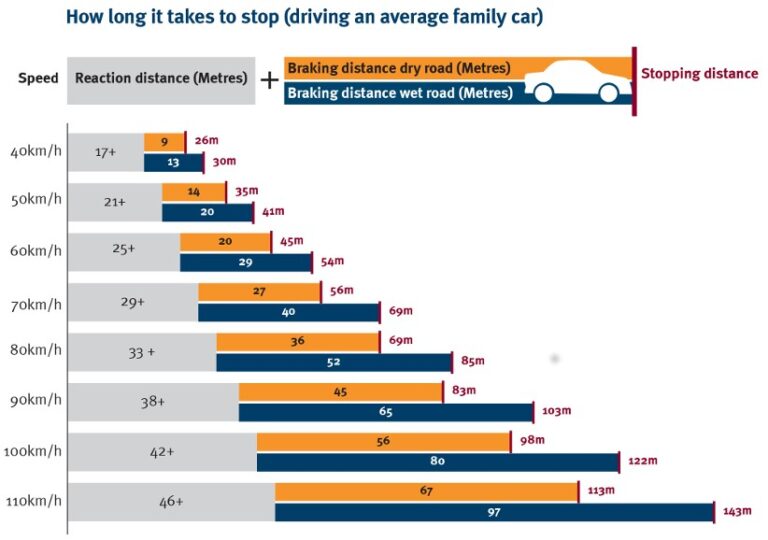This information comes from the Queensland Department of Transport and Main Roads
The simple truth about speeding is: the faster you go, the longer it takes to stop and, if you crash, the harder the impact. Even small increases in speed could have dire consequences.
As an example, a vehicle travelling at 67km/h will still be travelling at approximately 30km/h when the same car, braking at the same time, but travelling at 60km/h comes to a complete stop. If a pedestrian had stepped onto the road, the difference could be a matter of life or death.
Australian research^ has shown that the risk of a serious crash doubles with a 5km speed increase on 60km urban roads or with a 10km increase on rural highways.
In an emergency, the average driver takes about 1.5 seconds to react and stopping distances increase exponentially the faster you go.
The stopping distances on the graph above are calculated based on the following assumptions:
- In an emergency the average driver takes approximately 1.5 seconds to react
- A modern vehicle with good brakes and tyres is capable of stopping at approximately 7 m/s2 once brakes have been applied
- a dry road that is sealed and level has a coefficient of friction of approximately 1
- A wet road that is sealed and level has a coefficient of friction of approximately 0.7.
The stopping distances in the graph above are generic and may be influenced by a number of driver, vehicle and environmental factors:
Driver factors
- Attention
- Fatigue
- Impairment due to alcohol and drugs
- Vision issues
- Driver age and experience
- Hazard perception ability
Vehicle factors
- Vehicle age
- Type and condition of brakes
- Type and condition of tyres, including tyre pressure
- Safety features fitted to the vehicle (e.g. ABS, ESC, EBA, etc.)
- Vehicle weight
- Towing a trailer or carrying a heavy load
Environmental factors
- Road surface
- Road gradient
- Road alignment
- Weather conditions
^Kloeden CN, McLean AJ and Glonek G, 2002. Reanalysis of travelling speed and the risk of crash involvement in Adelaide South Australia, report CR 207, ATSB, Canberra. Kloeden CN, Ponte G and McLean AJ, 2001. Travelling speed and the risk of crash involvement on rural roads, report CR 204, ATSB, Canberra.







